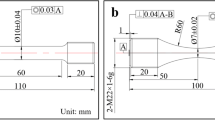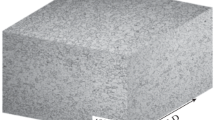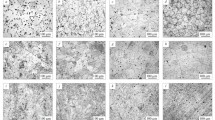General conclusions
-
1.
Small additions of silver can exert marked effects on the structure and properties of several aluminum alloys. It is believed that so-called trace elements effects such as this will assume increasing importance in the future because, in many alloy systems, the combinations of major alloying elements have been investigated.
-
2.
The most significant effects of silver additions are observed in alloys based on the Al-Zn-Mg system. On the basis of endurance lives in a range of environments, the stress-corrosion resistance of Al-Zn-Mg-Cu alloys is increased while still maintaining a high level of strength. The addition of silver has been shown to increase the threshold stress for stress-corrosion cracking in an industrial atmosphere but this has not been confirmed for alternate immersion tests in a NaCl solution. Overall, the effects of silver are most marked if the addition of silver is made in conjunction with minor modifications to certain other alloying elements, and a higher ageing temperature is used (e.g. 165°C).
-
3.
There is evidence that the stress-corrosion resistance of welded Al-Zn-Mg alloys is increased if silver is added to the parent metal or solely to the filler rod.
-
4.
Silver additions may modify the structure and properties of aged Al-Mg and Al-Cu-Mg alloys (providing the Mg: Cu ratio is sufficiently high). One possible practical implication of these results is that silver may increase the elevated temperature stability of certain Al-Cu-Mg alloys and preliminary results have been obtained for one experimental composition.
-
5.
From the fundamental viewpoint, it is considered that the effects of silver on the precipitation processes in certain aluminum alloys arise because of an interaction between silver atoms, magnesium atoms, and vacant lattice sites. The interaction is believed to modify the nucleation processes of the particular precipitates although the mechanisms differ depending on the alloy concerned. In alloys based on the Al-Zn-Mg system, silver stimulates nucleation of the existing precipitate whereas silver promotes the formation of a different precipitate in a wide range of Al-Cu-Mg alloys.
Similar content being viewed by others
References
I. J. Polmear, J. Inst. Metals, vol. 86, 1957–58, p. 113.
I. J. Polmear, ibid., vol. 87, 1958–59, p. 24.
I. J. Polmear & J. Scott-Young, ibid., p. 65.
I. J. Polmear, Nature, vol. 186, 1960, p. 303.
I. J. Polmear, J. Inst. Metals, vol. 89, 1961–62, p. 51.
I. J. Polmear, ibid., p. 193.
I. J. Polmear, Metal Progress, vol. 81, 1962, p. 82.
J. T. Vietz, K. R. Sargant & I. J. Polmear, J. Inst. Metals, vol. 92, 1963–64, p. 327.
I. J. Polmear & K. R. Sargant, Nature, vol. 200, 1963, p. 669.
I. J. Polmear, Trans. Met. Soc. A.I.M.E., vol. 230, 1964, p. 1331.
J. H. Auld, J. T. Vietz & I. J. Polmear, Nature, vol. 209, 1966, p. 703.
J. T. Vietz & I. J. Polmear, J. Inst. Metals, vol. 94, 1966, p. 410.
E. Di Russo, Aluminio Nuova Metallurgia, vol. 33, 1964, p. 505.
H. S. Rosenbaum & D. Turnbull, Acta Met., vol. 6, 1958, p. 653.
A. Kelly & R. B. Nicholson, “Progress in Materials Science”, Oxford (Pergamon Press), vol. 10, 1963, p. 244.
J. D. Embury & R. B. Nicholson, J. Aust. Inst. Metals, vol. 8, 1963, p. 76.
R. B. Mears, R. H. Brown, & E. H. Dix Jr., “Symposium on Stress Corrosion Cracking of Metals”, 1944, p. 329, (A.S.T.M. & A.I.M.E.).
G. Thomas & J. Nutting, J. Inst. Metals, vol. 86, 1957–58, p. 7.
G. Thomas & J. Nutting, ibid., vol. 88, 1959–60, p. 81.
G. Meikle, ibid., vol. 85, 1956–57, p. 540, (discussion).
W. Rosenkranz, U. S. Patent, 2,823,994, 1958.
I. J. Polmear, J. Inst. Metals, vol. 94, 1966, p. 36.
K. G. Kent, “Proceedings of Second Commonwealth Welding Conference”, 1965, p. 260 (discussion).
J. M. Truscott & D. S. Calvert, J. Inst. Metals, vol. 95, 1967, p. 289.
W. Rosenkranz, Aluminium, vol. 39, 1963, p. 290, 630, 741.
W. Shütz & E. Gassner, Laboratorium fur Betriebsfestigkeit, Tech. Note 13/65.
E. Di Russo, Aluminio Nuova Metallurgia, vol. 34, 1965, p. 331.
E. Lindstrand, Private communication.
R. W. Elkington & A. N. Turner, J. Inst. Metals, vol. 95, 1967, p. 294.
C. Panseri & E. Di Russo, Aluminio Nuova Metallurgia, vol. 30, 1961, p. 549.
R. Chadwick, N. B. Muir, & H. B. Grainger, J. Inst. Metals, vol. 85, 1956–57, p. 161.
D. James, J. Roy. Aero. Soc., vol. 70, 1966, p. 763 & Private Communication.
H. A. Holl, Corrosion, vol. 23, 1967, p. 173.
G. Lorimer & R. B. Nicholson, Acta Met., vol. 14, 1966, p. 1009.
D. O. Sprowls & R. H. Brown, “Stress Corrosion Mechanisms for Aluminium Alloys”. Paper presented at an International Conference on Fundamental Aspects of Stress-Corrosion Cracking. The Ohio State University. Sept. 1967.
J. H. Auld, Acta Met., vol. 16, 1968, p. 97.
J. H. Auld & B. E. Williams. Acta Cryst., vol. 21, 1966, p. 830
J. T. Vietz & I. J. Polmear, Op. cit., Reference 23, p. 254.
J. M. Silcock, J. Inst. Metals, vol. 89, 1960–61 p. 203
R. N. Wilson & P. J. E. Forsyth, ibid., vol. 94, 1966, p. 8
Author information
Authors and Affiliations
Additional information
Portions of the research for this paper were undertaken while the author was a Principal Research Scientist, Materials Division, Aeronautical Research Laboratories, Dept. of Supply, Melbourne, Australia. Contributions made by his former colleagues are gratefully acknowledged, with thanks given to the other laboratories which participated in the investigation, and to Messrs. C. J. Leadbeater, British Ministry of Technology, and R. Schmidt, U. S. Dept. of the Navy.
Rights and permissions
About this article
Cite this article
Polmear, I.J. The Influence of Small Additions of Silver on the Structure and Properties of Aged Aluminum Alloys. JOM 20, 44–51 (1968). https://doi.org/10.1007/BF03378722
Published:
Issue Date:
DOI: https://doi.org/10.1007/BF03378722




